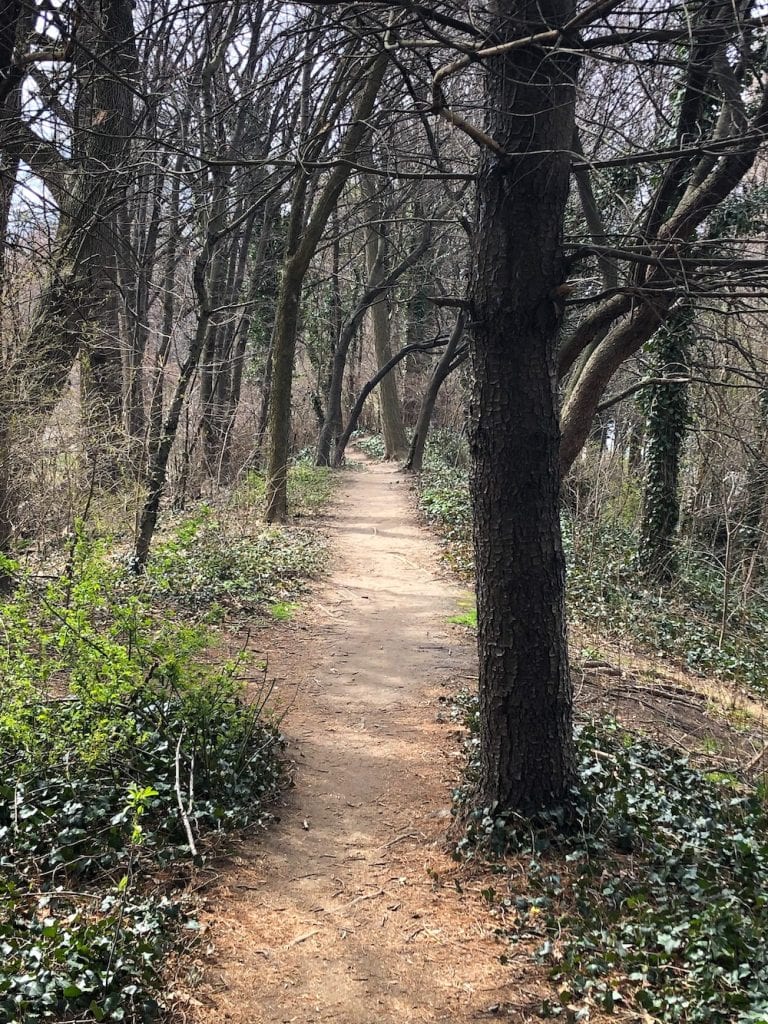Finding the dirt and rocks in Prospect Park and wondering if it’s enough.
Moving To The City
An essential part of my coping mechanism for when I moved to New York City this past year was going to be trail running and cross country skiing in Brooklyn’s Prospect Park. I’m sure that sounds ridiculous but the Long Meadow looks like a beautiful stretch of land from a Google Earth point of view and I figured that there had to be dirt to run on somewhere in the city.
Completely committed to trail running, I was not going to let becoming a city dweller get in my way. I was determined to find the potential for running in the green spaces that surrounded me. Prospect Park was my great hope and I became determined to learn all of its trails.
Of course, I did not ski in Prospect Park this winter. Not because I didn’t want to or because I couldn’t find the time, but rather because the sky was either unable or unwilling to play its part. Brooklyn saw nearly no snow this winter, and all 526 acres of the park remained their dormant browns and greys.
I know this because I spent nearly every day running loops throughout the park. Everyday, hustling astride morning runners, I willed the sky to pour forth in frozen showers, and it did on a few magical runs, but the snow never lasted and my midwestern heart was cruelly broken by the big bad city. Instead, I watched the Long Meadow glare at me, like the mud patch where the carnival comes to town, day after day.
Curiosity for bucolic experiences drove my city runs deeper into the park in an attempt to fill a mountain sized hole in my soul.
And, it turns out that Prospect Park is home to a small network of confused trials and hills — a tonic for any city trail runner who does not have the time or patience for the BQE or interstate 95.
Rambling on the park trails leads to a curious collection of park landmarks, all of which have mythic names like Vale of Cashmere and The Ravine, calling out to Gothic sensibilities. The Camperdown Elm is a tree that looks as though it’s under water and was a gift in 1872 as a crowning curio for the park. It is accessible by concrete path. Lookout Hill served as a, you guessed it, look out for Washington’s troops during the heroic debacle that was the Battle of Brooklyn, painfully illuminating the realities of the early Revolution. It can be reached by a series of shallow stone staircases that are ominous on slick mornings. The Quaker Cemetery is a private, fenced off spot in the woods that is obscured from nearly every vantage point, even in the bareness of winter. A horse trail (that’s right) can be used to get a small glimpse of headstones.
There are, however, many significant trail running landmarks that are less obvious, though their absence from the park website PDF map does not lead me to believe that I am the first or last human to label these locals. Any Prospect Park trail runner will need to become acquainted with the secret landmarks, and become adept at dodging horse poop.
Finding The Hidden Trails
“Mean Hill” is less a trail and more a stone slide for water run-off that is mostly just the best place in town to roll your ankle, though there is a curious stone foundation near the top. Litter also decorates the summit, but that is a common theme amongst the park’s best kept secrets.
“Condom Hill” is less of a hill and more of a hidden landing that must be approached through reckless scrambling and root gripping. The floor is a literal mosaic of condom wrappers all glittering, no matter the weather, in the most intentional of ways that will have spectators torn between declaring it as art or litter (it’s litter). Condoms and condom wrappers are perhaps the most abundant trash in the deep trails of the park. Dunkin and Starbucks cups are second, with nibs and blunt wrap wrappers picking up the bronze.
“The Mud Hole” is the muddiest place in town, where you can regularly find ankle deep black mud even when it hasn’t rained in days. The trail is short and its true purpose is completely unknown. There is another regularly muddy spot near the top of an annoying silent struggle of a gravel hill, but it already has a real name. For the Mud Hole, shoes with proper lugs are highly recommended.
And then there is the “Secret Path”, which can only be found by desperately plunging into the woods in a direction that could not possibly have a trail, but of course holds the best trail running in the entire park, maybe the entire city. The ground weaves through trees in a tight single track that rips along as you spring over root and rock. My neon orange hat — bought when I lived in Michigan to avoid the perils of the woods during deer season — must have been the only visible part of me from the other trails. I have only ever seen one other person on the Secret Path and we scared each other like startled deer, our eyes flashing, proof of the transportive nature of its dirt. I don’t know what room-of-requirement magical forces are required to find that trail and I’m not going to ask.
The list of side trails and questionable scrambles goes on and on, from the Wooden Switchback to the Bridal Path to The Ridge.
Making Sense of the Nonsense

If the loose ends of trails are connected just right, a runner can create numerous training routes that criss cross the park. Assembling chains of trails can easily lead to ten miles of unrepeated dirt, all in the heart of Brooklyn. Getting out of the city on the weekends and putting up higher mileage and vert numbers in the Hudson Highlands, Catskills, and Berkshires is important, but Prospect Park can offer many dirty miles underfoot in the meantime.
Still, living in the heart of a big city can be a true struggle for any adventure seeking trail runner.
Moving to the concrete, the lack of snowy adventure, can leave many feeling penned in and incomplete. I find myself constantly in conversation with other rural transplant friends lamenting the nature that we lost when we relocated. Green spaces like Prospect Park potentially have the same nature fix properties of Japanese forest-bathing, outlined by authors like Florence Williams, but our bodies know wilderness when we see it.
Mary Oliver asks, “What is it you plan to do with your one wild and precious life?” While living in the city, I point to the concrete and steel outside, shrug my shoulders, and hope that I don’t naively run out of time before I have the chance to make her proud. My running and skiing excursions in the park were supposed to paper over the cracks. When asked whether or not I was living a true life out in the capital W World, I was just going to hold my muddy shoes up and smile. And I have along the way.
Maybe city trail runners should be content with “Condom Hill” and the “Secret Path”. Maybe city trail runners should even be content with the 3.3 mile concrete circuit that wraps the park. It is still running after all, and we can certainly still get in our miles before race day. Maybe, as I spent the winter ticking off miles in the park, I should have said, ‘I know that you still hear me, capital W World, even here, underneath the pavement and cables, subways and sewers. You still hear the soft prayer of my feet, beating out time.’ And that should count as enough.
My winter running highlighted that the real loss isn’t the skiing at all, but actually that no skiing means no snow, and no snow ought to be to be the canary in the coal mine. Maybe the bird watchers and prework pot smokers that I startled as I appeared crashing out of the woods each week should be just as concerned about what a mild snowless January we had this year. In fairness, maybe they are.
Lessons Second Time Around
Earlier this year, I was at the American Museum of Natural History in Manhattan. The Museum is easily one of my favorite parts of New York, and I’m sure that I am in good company amongst its five million annual visitors. Some of my favorite stuff in the museum is actually those funny dioramas with taxidermy animals and idyllic arced background paintings. I love them all: New England in Fall, the pond habitats, the farms in planting. Of course, those scenes were all originally assembled to depict our present world — to bring the ecosystems of the continent to the city exhibit.
But, I couldn’t help chase away the feeling that I was looking at the past tucked behind the glass window of each scene. The stuffed jay yelling at the fox and the painted praying mantis seemed more and more at home next to the trilobites and mammoth skeleton. Bisections of the old groth giants felt more like traveling through time than over distance. I wondered, as pods of school kids peered from one scene to the next, if they felt like they were traveling the World, or if the glass eyed Saw Whet owls, who still hide in our forests, had become as alien as the Ice Age giants in the exhibit next door? We were all at the Natural History Museum, after all.
I left the Museum that afternoon and wandered into Central Park, Prospect Park’s mild mannered cousin, and it occurred to me that maybe I was kidding myself with the running and the skis. Was it possible that the capital W World that we are chasing is actually history, found only in the pastoral backdrops of recreations? Was the bareness of the Long Meadow actually screaming out in its own final days? Are the rocky trails in Prospect Park related to the White Mountains? I don’t really know. But, I will continue to put my miles in along the Secret Path, summit Lookout Hill, and dirty my shoes in the Mud Hole until I find out.
If you have musings, great itineraries, or other stories you’d like to share with our community – you can submit your piece for review here.

